Having to find the nearest gas station to use their RV tire inflator can be a pain. Having a portable RV air compressor that runs on 12V DC power will allow you to fill your tires wherever you’re currently parked.
And once you try one, you’ll wonder why you relied on gas stations or small electric pumps for so long.
The off road air compressor has many functions. You can use it to fill almost any recreational inflatable you can think of including paddleboards, kayaks, footballs, volleyballs, and anything else that requires ample PSI to serve its intended purpose.
But their main purpose is in monitoring and maintaining your RV’s tire pressure, which is critical if you like to travel or live in remote locations or When travelling off-road.
If you have an air 12-volt air compressor with your RV, you won’t have to make it to the next gas station with an air pump in order to top off the air in your tires.
There’s actually quite a wide range of RV air compressors and tire inflator out there. They also vary quite a bit in quality and prices.
But, fortunately for you, I’ve researched the market to bring you five great RV air compressor for throughout that range so you can find best 12V RV air compressors that works best for you.
5 Best Portable RV Air Compressor Reviews
Most of the best RV air compressor options are portable models that are easy to store underneath your RV.
But I’ve also included at least one onboard compressor if you’re looking for a more permanent, mounted solution. So let’s dive into these compressor reviews!
Here Are Our Top 5 Picks For The Best 12V portable air compressor to Inflate high-pressure RV tires while off-roading.
1. Best Overall: Viair 40047 400P Portable Air Compressor Kit For RV
If you’re looking for the best overall 12v off road air compressor that’s going to be compatible with most recreational vehicles, look no further than the Viair 40047 400P-RV Compressor Kit.
This portable compressor is high-powered but lightweight and it won’t take up too much space under your RV when you’re not using it.
It has a high flow rate of 2.3 CFM @ 0 PSI and a maximum rating of 150 PSI.
It’s important to realize that its flow rate will decrease as the pressure inside your tire increases, but its lowest flow rate will be 0.71 CFM @ 150 PSI.
This is by design because a lower flow rate at higher pressures helps to protect your tires from over-inflation.
And speaking of over-inflation, this 12v off road air compressor comes with an automatic shutoff feature that allows you to set your desired PSI when inflate the tires of your recreational vehicles.
So you’ll be able to walk away and check the pressure on your other tires without worrying about over-inflating the one your compressor is currently hooked up to.
Accessibility should also be no issue even for large RVs with this compressor.
For starters, the power cord that comes with it is eight feet long and then it comes with a primary air hose that’s 30 feet in length.
But if you’re working on a particularly long RV, it also comes with an additional 30-foot extension hose so that you don’t have to move the compressor itself around in order to inflate all of your tires.
This is truly an all-inclusive compressor kit because of all the accessories it comes with.
You’ll get a quick tire inflation gun with a built-in pressure gauge, dual battery clamps that allow you to connect it straight to your RV battery, a 45-degree extended reach tire chuck that helps you access the inside tires if your RV has dual rear wheels, and anything else you need to make inflating easy and painless.
Things We Like
Things We Don’t Like
2. Best 12 Volt Air Compressor: TIREWELL 12V 150PSI RV Tire Inflator
If you’re looking for a heavy-duty 12-volt air compressor that includes a direct drive metal pump, the Tirewell 12V RV Tire Inflator is an excellent choice.
This pump is rated to provide 2.12 CFM @ 0 PSI, which is enough to inflate a standard RV tire in about two minutes. But it also comes with enough adapters to inflate pool toys, bicycle tires, and other sporting equipment.
The 12-volt air compressor itself is super lightweight (just over 8 pounds) so that’s it’s easy to move around your RV to each tire. This is important because it only comes with 1.8-feet of rubber air hose.
So you’ll have to get this compressor close to each tire in order to inflate them. But it does give you the ability to power it via your RV battery or the cigarette lighter.
The direct-drive motor on this compressor makes it both highly efficient and less noisy. Inside the motor, two cylinders actually compress air at the same time.
This double-cylinder design actually reduces the rotating speed of the motor while still providing plenty of power. By reducing rotating speed, the efficient design of this compressor helps to extend its lifespan.
The only knock I could find on this 12-volt compressor is that it requires a direct connection to your RV battery or into the cigarette lighter to be powered up.
While it only draws 15 amps at maximum flow, I can see accessibility being a potential problem with this pump.
If you have a longer RV, you may need to purchase an additional extension air hose in order to reach all of your tires.
Things We Like
Things We Don’t Like
3. Best Portable RV Air Compressor: PORTER-CABLE (CMB15) Portable Air Compressor Kit
Those searching for a super-compact portable RV air compressor that is really easy to use shouldn’t pass on the Porter-Cable Compressor Kit.
It’s also the only fully shrouded compressor on our list, which makes it one of the quietest RV air compressor on the market.
One of the best parts of this kit is that everything stores or attaches right to the shroud so you won’t have to keep track of spare parts and accessories.
This portable air compressor is rated to provide 2.0 CFM @ 90 PSI and it’s capable of a maximum PSI rating of 150.
That higher CFM rating at a higher pressure allows this compressor to recover more quickly than others.
That means less time waiting for compressor recovery in between filling tires.
The portable air compressor includes a 1.5-gallon air tank within the shroud so you don’t have to worry about attaching it to an external air tank.
This also makes it easier to carry and allows the compressor to run longer without needing to be shut off to recover.
This RV portable air compressor has also been tested to emit just 79 decibels of noise emission when operating at full capacity.
I like that it includes a 120-volt motor that draws low amperage. This means you can plug it into any outlet inside or outside your RV for easy use.
And it comes with a 25-foot air hose so that you can access all your tires without moving the compressor unit itself many times over.
For smaller RVs, this amount of air hose is probably enough to access all tires, but larger RVs may have to relocate the compressor once to inflate everything.
It also comes with an eight-piece accessory kit so you can inflate more than just your RV tires.
And last, but certainly not least, this is one of the few compressors that features an oil-free pump design.
This translates to a longer motor lifespan and less maintenance for you throughout the life of your pump.
Things We Like
Things We Don’t Like
4. Best Off Road Air Compressor: GSPSCN Double Cylinders Portable RV Air Compressor
If you’re in search of a budget-friendly Off Road Air Compressor that still does its job, the GSPSCN Heavy-Duty Compressor is one of the most affordable options on the market.
That said, it’s still rated for nearly 2.46 CFM @ 0 PSI and offers excellent versatility to support a variety of inflation applications.
This compressor’s flow rate is enough to inflate a 200/70/R18 tire in just 1.5 minutes and, like the Tirewell Compressor, it includes a direct-drive motor with dual cylinders for more efficient operation.
The two cylinders in this motor both compress air at the same time, which allows the motor itself to rotate at slower speeds.
This has a number of benefits, including quieter operation, longer motor lifespan, and more efficient airflow.
You also won’t have to worry about this compressor falling over on the job. For one, it has a low center of gravity that makes it unlikely to tip when inflating.
But it also includes rubber feet on the bottom that help to absorb vibrations and further stablize the entire compressor unit.
By absorbing vibrations, these rubber feet also reduce the amount of noise that the compressor produces when operating.
The only potential issue with this compressor is accessibility. It can either be powered using your cigarette lighter or a direct connection to your RV battery.
And because it only comes with an 11.5-foot cigarette lighter power cord and a 1.8-foot air hose, you may have trouble reaching all of your tires when the compressor itself is plugged in.
This might necessitate the purchase of an additional extension air hose.
Things We Like
Things We Don’t Like
5. Best On-Board Compressor: ARB CKMTA12 ’12V’ On-Board Air Compressor
If you require a compressor that can permanently be installed in your RV because you’re going to be using it a lot, the ARB CKMTA12 Twin High-Performance Compressor is the only ‘onboard compressor’ on our list.
This compressor can permanently mount in your RV and it comes with a full wiring loom to aid in the electrical installation.
Also, if you need a compressor that provides best-in-its-class airflow, it’s hard to overlook one that provides 6.16 CFM @ 0 PSI.
It’s capable of achieving this higher flow rate due to the twin motor, dual cylinder design.
These motors are both thermally protected against damage from extreme temperatures.
They each also use a heavy-duty in-line maxi fuse for individual circuit protection.
Inside the housing, a high-powered brushless fan helps to keep the motor, electronics, and relays from overheating.
This fan design helps to improve the lifespan of the compressor and its parts while also supporting longer run times.
The compressor housing itself is highly resistant to dust and water. It boasts an IP55 Ingress protection rating.
While you will need to spend a little more time to mount this compressor and wire it into a 12-volt or 24-volt DC electrical connection, it comes with everything you’ll need to complete the installation.
The full kit also comes with a number of adapters and fittings that allow you to use this compressor for much more than just inflating your RV tires.
Another thing that’s worth mentioning about this compressor is that it includes an over-pressure safety valve.
This valve shuts the compressor down when the set pressure is reached. And if you have it permanently mounted in your RV with your desired pressure set, it’s only going to make checking and refilling your tires that much quicker and easier.
My only concern with this compressor is that I couldn’t find anywhere how much air hose it comes with.
So it appears that you may also need to purchase enough air hose length to reach all the way around your RV from wherever you plan to mount this air compressor.
Things We Like
Things We Don’t Like
Factors To Consider When Shopping For An Portable RV Air Compressor
Buying the right portable RV air compressor online can require a bit of research.
But we’ve done that research for you in our Buying Guide, where we’ll highlight the most important features and technical specifications you need to understand before purchasing a new portable air compressor.
Portable Air Compressor Type
The most common type of compressors used for recreational vehicles is the portable variety.
Portable compressors are useful because they’re generally easy to transport and don’t take up a whole lot of space in your RV.
If you’re only using it to inflate your RV tires, you’ll be able to move it around your rig to access each tire individually.
There are, however, onboard compressors that can be permanently installed in an RV’s underneath compartment. These models have the benefit of being able to remain stationary during use.
However, they don’t work for all types and lengths of RVs because they require enough hose length so that you can reach all your tires without hassle.
Additionally, onboard compressors sometimes require a more complex installation process.
You’ll need to make sure the compressor itself is mounted solidly in the location of your choosing, for starters.
And then you’ll need to plug it into a more permanent power supply than you’d typically require for a portable compressor.
For these reasons, most RVers choose portable compressors over any other type.
Their ease of use, portability, and adaptability make them the easy favorite for the best type of RV air compressor.
PSI and CFM Ratings
PSI stands for ‘pounds per square inch’ and CFM refers to ‘cubic feet per minute’. These ratings are commonly advertised when you’re comparing air compressor models.
If they aren’t, that should immediately create some cause for concern.
PSI is a measure of air pressure and a compressor’s PSI rating signals how much pressure it can fill tires (or other inflatables to).
Your tire’s PSI rating should be easily found on their sidewall, but you can always consult the manufacturer’s specifications for that specific tire size and make if you’re having trouble finding the recommended PSI on the sidewall.
Simply put, your air compressor’s maximum PSI output should be higher than the recommended PSI for your tires.
But if there’s something you intend to fill with your compressor that requires a higher PSI than your tires, the compressor you choose should have a higher output that that item’s recommended PSI.
A compressor’s CFM (cubic feet per minute) rating tells its airflow rate. A compressor with a higher CFM rating will be able to fill your tires faster.
These metrics are typically presented together in the following format: ‘4.6 CFM @ 80 PSI’.
Noise Emission
By nature, air compressors are pretty loud RV accessories. Many of them produce much more noise than a standard electric pump and might cause your RV park neighbors to turn their heads.
But they aren’t the ones that will be in close proximity to the compressor when you’re operating it.
You can always wear earplugs if you choose an especially loud compressor, but many quality compressors advertise the decibel level they produce when operating.
On average, most portable compressors produce between 40 and 90 decibels of noise emission.
If I were choosing for myself, I’d do my best to select a model that produces 65 decibels or fewer.
This is closer to the amount of noise produced by a vacuum cleaner or a hair dryer and, while it’s not particularly music to my ears, I’d be willing to suffer the noise in exchange for the ability to inflate my tires in seconds.
Weight and Hose Length
Air compressors designed for RV use tend to be more compact and lightweight than other traditional models. That being said, some are certainly much heavier than others.
As a buyer, you need to keep in mind how much weight you’re comfortable moving around and adding to your RV’s weight load.
The weight of your compressor will also come into play if it doesn’t come with enough hose length to reach all of your tires when the compressor itself is positioned in one place.
If this is the case, you’ll need to move the compressor multiple times in order to fill all of your tires and that is going to be cumbersome if you choose a really heavy model.
On the other hand, if the 12V air compressor comes with enough hose length to reach all of your tires when it’s positioned in a single location, you won’t have to worry about moving it and weight will be less of a factor.
When considered together, a compressor’s weight and hose length will tell you a lot about how easy it will be to operate efficiently.
Versatility
The primary application for these portable compressors is to inflate RV tires. But some of them are versatile enough to handle a variety of additional applications.
This includes inflating recreational toys, tires on OHV vehicles, filling air mattresses, and more.
The compressor you choose should be versatile enough to handle all of your inflation needs.
A compressor’s versatility is largely determined by your ability to control its airflow rate and the number of fittings it comes with.
One frustrating thing about inflatable equipment is that they tend to come with many different openings for inflation.
I honestly wish we could just figure out a standard nozzle for all inflatables, but that might be futuristic thinking.
Anyhow, your compressor should come with a variety of fittings so that you can adequately inflate tires and equipment with different types of nozzles.
If your compressor only comes with one fitting meant for RV tires, it will probably be great for that single application but it might not offer the versatility you’re looking for.
Durability
Some of these compressors aren’t the most affordable RV accessories on the market, so when you choose one you should be confident that it’s going to last.
A durable compressor will be made of high-quality materials and should always include rubber feet to minimize vibration and keep the unit in place while you’re inflating.
A good sign of a durable air compressor is also an insulated rubber hose.
Not many of the best RV air compressor models don’t include this type of hose, but it’s easily the safest and most durable selection possible for compressors that have high PSI ratings.
Operating Time and Recovery
Every compressor is capable of running for a certain amount of time before it needs to cool off.
Most of these portable compressors don’t require air tanks so they’re not restricted by the size of that tank.
If they do (like the Porter-Cable Kit), that air tank will largely dictate how long the compressor can run before needing to recover.
Because direct drive compressors pull from external air without the need for an air tank, they tend to have the longest operating time and the shortest recovery time.
But certain models have specifically adapted their designs to include features that reduce recovery time.
Simply note each compressor’s rated operating and recovery times so that you have a good idea of how long it will take you to inflate your RV tires.
So, Which Is The Best 12 Portable Volt Air Compressor For RV?
The Viair 40047 400P-RV Compressor Kit is our choice for the best overall RV air compressor because it’s a true one-size-fits-all solution. It comes with over 60 total feet of air hose and an additional eight feet of power cord length.
So even longer RVs won’t be a problem and it also includes a variety of adapters and fittings that allow you to inflate bicycle tires and other sporting equipment.
But if you’re not quite sold on that option and you’re looking for something a bit more compact, we also love the Porter-Cable Compressor Kit.
It’s easily the smallest and most lightweight choice on our list and it still offers plenty of performance of all of your inflation needs.
But it’s also rated for up to 150 PSI and it has a better recovery time than many comparable compressors.
Frequently Asked Questions
What’s still puzzling you about these RV air compressors? Let’s dive a little deeper before we conclude to answer the most frequently asked questions about RV air compressor operation, maintenance, and more.
What’s a good PSI rating for an RV air compressor?
The average rating amongst all RV compressors is about 90 PSI. But you’ll certainly find that some of the compressors we’ve reviewed have a rating above 150 PSI.
These are the highest-powered compressors that are capable of inflating your tires to appropriate PSI in a matter of seconds.
The only downside of a compressor with a higher PSI rating is that it will tend to be heavier and bulkier, which can make storing it underneath your RV more difficult.
What size air compressor do I need?
Your RV tires are typically going to be the item you’re inflating that requires the most PSI. But it’s possible that you want to inflate something that requires more.
To put it simply, you’ll need an air compressor that can provide more PSI that your largest inflatable item requires.
So if your RV tires require 45 PSI, for example, you’ll want an air compressor rated for more than that.
Can I use an air compressor to winterize my RV?
Yes! But you need to be careful when doing so. Whenever you store your RV for the winter months, you’ll need to winterize the water lines.
Some RVers fill their lines with an antifreeze solution that’s rated for appropriate winter temperatures, but you can also completely clear all the water out of your lines to keep them from freezing. To do this, some folks use an air compressor.
However, you don’t need a high powered compressor like some of the options we’ve included in our reviews.
We recommend using something like a 20g tire inflator to blow any remaining water out of your pipes after you’ve allowed gravity to clear the majority of the lines.
Using too much PSI to blow the water out of your lines can actually cause more harm than good.
What is the biggest danger to the life of my compressor?
Moisture! It’s really important to keep your compressor dry because moisture is the enemy of all compressors.
Trying to use your compressor in the rain creates a significant risk of power short, which can cause damage both to you and the compressor itself.
Additionally, very humid environments where there is a lot of moisture in the air can be a problem for air compressors.
Most compressors rely on rotating metal screws that have a tendency to suck air in. If that air is very wet, these screws will accumulate rust much more quickly.
In the worst case, they can even completely fuse together and cause the compressor to malfunction.
How do I maintain and check RV tire pressure with my compressor?
In order to fill your RV tires using an air compressor, you’re going to want to begin by making sure the compressor is equipped with a tire chuck.
This is a small tool that depresses the tire valve in order to allow air to flow in.
While a tire chuck can be added later, it’s easiest to have a compressor that already comes with one.
Next, you’ll want to set the compressor hose onto the tire valve and lock it into place.
If your compressor has a built-in pressure gauge on it, you’ll easily be able to check the existing pressure in the tire before turning the compressor on.
Now, assuming you’ve already plugged your compressor into a power source, you can turn it on and monitor until the gauge reaches your desired PSI.
Some modern compressors even have a built-in shutoff mechanism that allows you to set the desired PSI that you want in your tires.
When the gauge reaches that PSI, the pump will automatically shut off to avoid over-inflation.
Conclusion
There are so many uses for a good RV air compressor when you’re recreating.
From inflating inner tubes for floating on the lake to keeping the pressure up in your RV tires, having an air compressor with your RV can make life a lot easier.
Otherwise, you’ll need to hit a gas station or rely on the slow operation or a smaller electric air pump when the need arises.
With a quality air compressor, you’ll be able to use your RV’s internal battery to provide power to the compressor motor.
From there, it’ll only be a matter of minutes before you’re inflated and ready to move on to your next adventure!

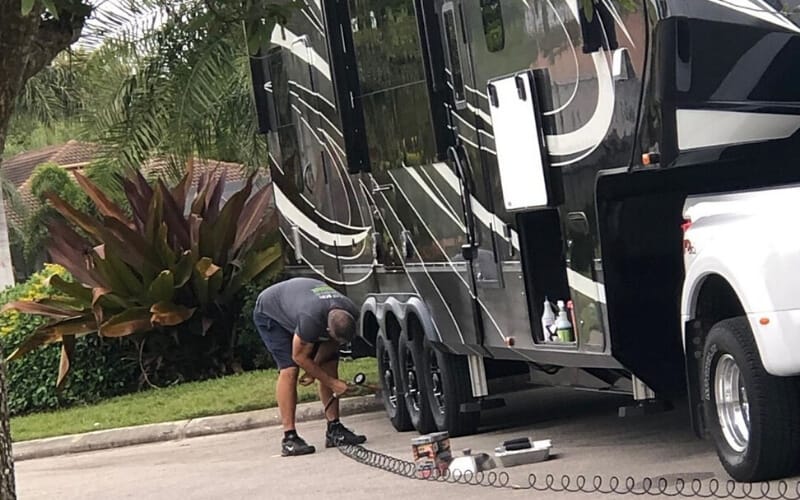
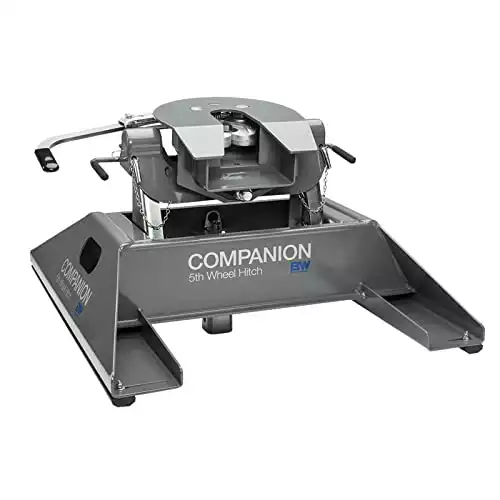
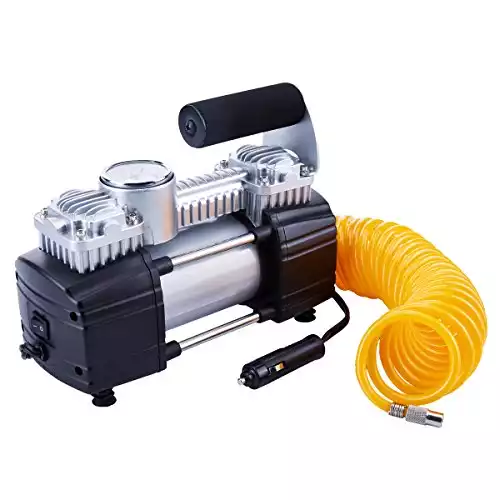
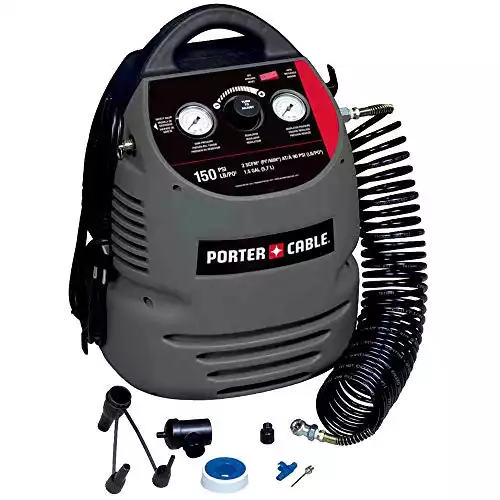
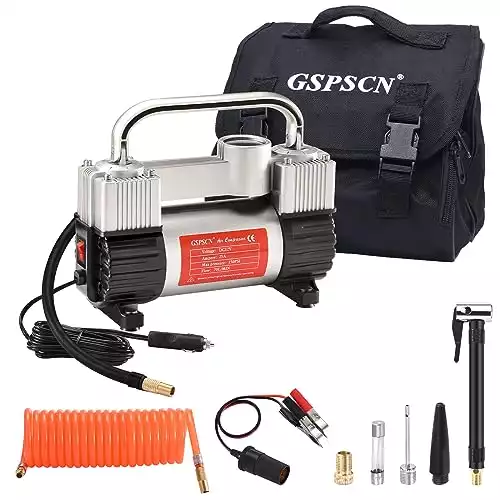
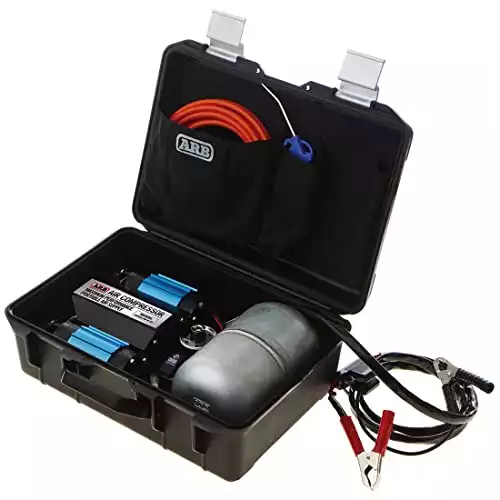
![The 6 Best RV and Camping Toilets in [currentyear] 7 Best RV Toilet](https://www.rvingknowhow.com/wp-content/uploads/2020/06/Best-RV-Toilet-150x150.jpg)

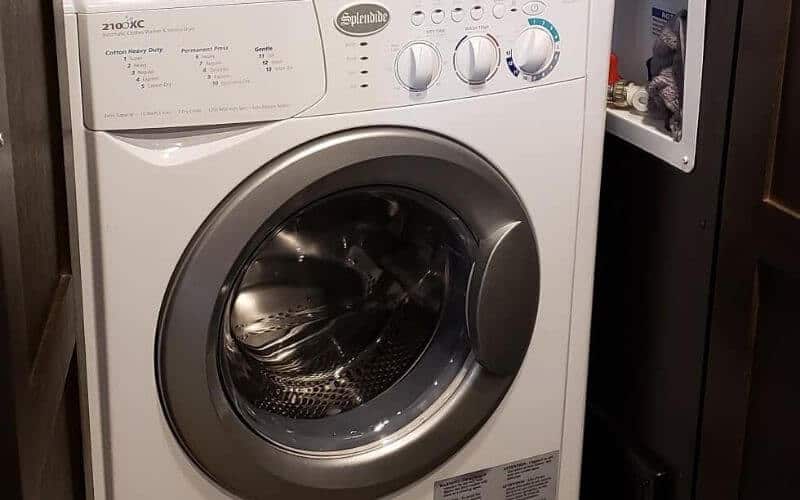
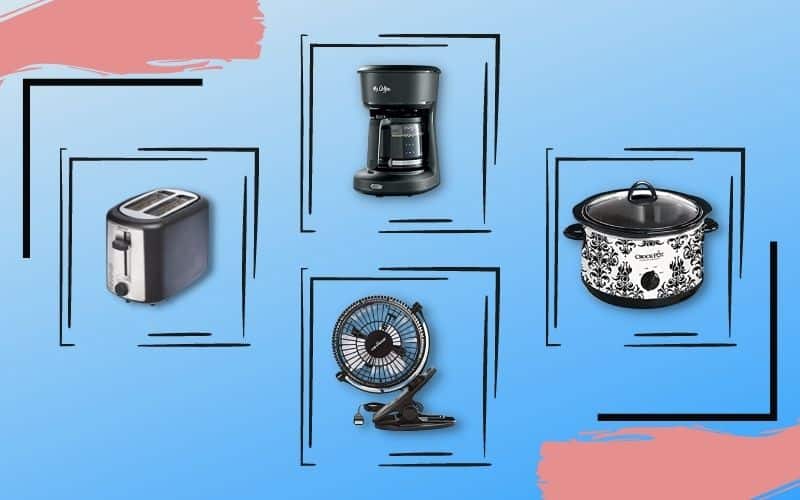
![5 Best RV Golf Cart Carriers in [currentyear]- Top Reviews by RV Experts 11 Best RV Golf Cart Carrier Options You Should Consider](https://www.rvingknowhow.com/wp-content/uploads/2022/05/Best-RV-Golf-Cart-Carrier-Options-You-Should-Consider.jpg)